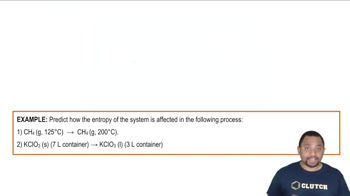Here are the essential concepts you must grasp in order to answer the question correctly.
Entropy of Vaporization (ΔS<sub>vap</sub>)
The entropy of vaporization is a thermodynamic quantity that measures the change in entropy when a substance transitions from a liquid to a vapor. It reflects the degree of disorder in the system; a higher ΔS<sub>vap</sub> indicates greater disorder in the gaseous state compared to the liquid state. This concept is crucial for understanding how temperature and energy changes affect phase transitions.
Recommended video:
Entropy and Physical Changes Example
Gibbs Free Energy and Phase Changes
Gibbs Free Energy (G) is a thermodynamic potential that helps predict the direction of chemical reactions and phase changes. The relationship between Gibbs Free Energy, enthalpy (ΔH), and entropy (ΔS) is given by the equation ΔG = ΔH - TΔS. For a phase change at equilibrium, ΔG is zero, allowing us to relate ΔH and ΔS to calculate the entropy of vaporization.
Recommended video:
Gibbs Free Energy of Reactions
Clausius-Clapeyron Equation
The Clausius-Clapeyron equation describes the relationship between the vapor pressure of a substance and its temperature, providing a way to calculate the entropy of vaporization. It states that the slope of the vapor pressure curve is proportional to the enthalpy of vaporization divided by the temperature. This equation is essential for understanding how changes in temperature affect the vaporization process and the associated entropy changes.
Recommended video:
Clausius-Clapeyron Equation




